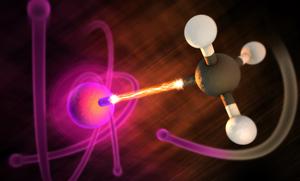Watching electrons jump in exploding molecules
17 July, 2014
Our results on charge transfer in dissociating iodomethane (CH3I) molecules by Erk, Boll, Trippel, et al has been published by Science. In this study, the maximum distance at which electrons can still transfer between the ionized iodine and methyl moieties of the dissociating molecule was measured. Detailed press releases are available from DESY, CUI, and SLAC.
Artist's concept of an exploding iodomethane molecule and its jumping electrons. Credit: SLAC National Accelerator Laboratory
Many chemical reactions – such as those at work in batteries and photosynthesis – rely on electrons moving from one atom or molecule to another. Now, scientists have directly measured the movement of electrons as they leap across parts of the same molecule, which provides useful insight about the mechanisms involved in forming and breaking chemical bonds.
The experiment took place at the Department of Energy’s SLAC National Accelerator Laboratory using SLAC’s Linac Conherent Light Source (LCLS) X-ray laser, a DOE Office of Science user facility. Scientists split molecules with pulses of infrared light and then hit them with intense X-ray pulses to drive and study the transfer of electrons between the fragments. The experiment showed that the electrons can travel surprisingly long distances – up to 10 times the length of the original, intact molecule – to jump the gap. The results are published in the July 18 issue of Science.
"This is a clean example of a very important charge-transfer process that can only be resolved using a tool like LCLS," said Artem Rudenko of Kansas State University, who led the experiment. The knowledge gained in the experiment may ultimately help to explain mechanisms of electron transfer in more complex molecules, including biological samples. This is also central to understanding how X-rays can damage samples and obscure X-ray images.
As a basic form of chemical reaction, electron transfer is vital to many life processes. The 1992 Nobel Prize in Chemistry recognized pioneering theoretical work in electron transfer that has underpinned many related chemistry experiments. The team studied methyl iodide molecules, also known as iodomethane, which break in a predictable way when hit by intense infrared light: One fragment contains a single iodine atom, the other has carbon and hydrogen atoms. They tuned the LCLS X-ray pulses to knock out electrons only from the iodine atoms, creating a positive charge that attracts electrons from the other fragment to fill the vacancies. As the fragments drift, the gap that electrons jump to reach the iodine atoms widens until it becomes too far for them to reach.
The researchers varied the timing of the X-ray pulses to tune the distance electrons had to jump to cross this gap. They used time- and position-sensitive detectors to determine the final charge and energy of the fragments, which told them where the remaining electrons ended up. While LCLS X-ray laser pulses are ultrashort, lasting just quadrillionths of a second, or femtoseconds, the electron-transfer process typically spans less than a single femtosecond, Rudenko noted. During this very short time, the distance between the fragments does not change, allowing researchers to more easily gauge the electron movement.
"With each pair of infrared and X-ray pulses we tried to look at just one molecule," said Benjamin Erk of Germany's DESY lab, who analyzed the data. "We traced essentially all of the fragments produced to give us a microscopic 'picture' of a single fracture event." Researchers collected data from about 800,000 fractured molecules. The same team, which was also led by Daniel Rolles of DESY, has already conducted follow-up research on other molecules at LCLS, and researchers said it may be possible to study biological compounds found in DNA and RNA, as an example, using the same method. They hope to directly measure the time it takes for the electrons to move across larger and more complex molecules, Rudenko said.
In addition to researchers from Kansas State University, DESY and SLAC, other collaborating researchers were from the Center for Free-Electron Laser Science, Max Planck Institute for Nuclear Physics, Max Planck Institute for Medical Research, University of Hamburg and Physikalisch-Technische Bundesanstalt (National Metrology Institute), all in Germany; and from Sorbonne University and the French National Center for Scientific Research in France.
The work was supported by the Max Planck Society, which funded the development and operation of the CAMP instrument used in the experiment; the U.S. Department of Energy Office of Science; the Kansas NSF EPSCoR “First Award” program; the Helmholtz Association; and the German Research Foundation's Hamburg Center for Ultrafast Imaging - Structure, Dynamics and Control of Matter at the Atomic Scale.
